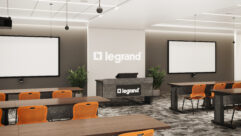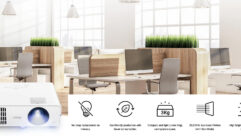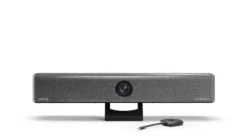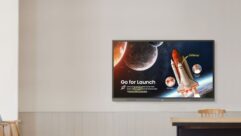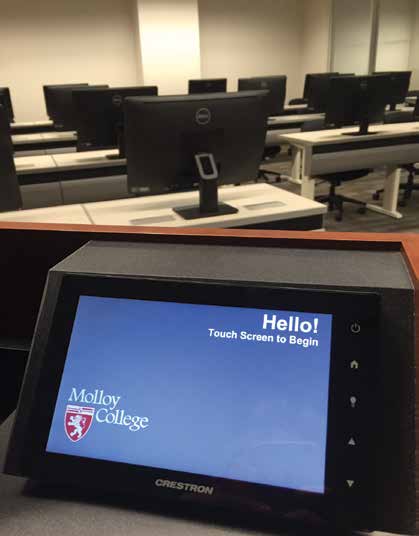

SVC: Molloy College and its new classroom facilities look like a major installation project with some pretty sophisticated AV systems. Before we get into that though how about telling us about Advance Sound Company.
Thomas DePace: We’re a systems integration firm here on Long Island and we’re celebrating our 45th anniversary this year. And you know over the past couple of years we’ve really excelled from an audio firm to a true systems integration firm, working on some large-scale projects for K through 12, higher education and corporate work.
And this project was not only sound but video and control, the whole works. It was a brand new building so you got a clean slate with this rather than upgrading an existing facility?
This building was a clean slate right from the steel up. So the nursing program at the school is actually one of the top-rated in the country and they needed a space that echoed the caliber of the program.
And what specific capabilities did Molloy College want to have when this new building was done and the systems were ready to use?

Besides having multifunction use for various other programs in the college, they wanted to make sure that the nursing needs were truly met. They have a simulation lab in the building and they wanted to be able to review video and audio from the actual simulations of the SIM modules giving birth or someone being sick and being able to take those and make them teaching experiences. They wanted to be able to disseminate that information to tiered classrooms as well as rooms where the doctoral students can meet and speak with industry professionals such as doctors and nurses and paraprofessionals.
OK. Of course there’s always a balance between giving them lots of sophisticated capabilities and making the system operation too complex. Describe the classroom setup for us. It looks like each student has their own mic right in front of them at their desks.
In the tiered classroom it’s really very tech-forward. There’s a Clockaudio microphone for every two seats and that really enhances the collaborative experience. That paired with some Axis cameras that track which microphones are on, and three projection screens in the room, they’re able to show the actual student projection. They’re able to show a presentation in the classroom as well as some sort of an outside source, whether that’s video conferencing or a collaborative source.
And you used the Clockaudio C012E-RF I believe with the CH32 base on it?
Yes, we did. In the tiered classrooms they’re probably the most durable, vandal-resistant microphones that we have and then paired with the touch ring it gives the professor or the person leading the lecture the opportunity to see who’s talking and who’s in the queue to talk. It gives them the opportunity to pick people that may not be so apt to talk, to speak as part of the presentation as well. So it allows the professor to really immerse the whole class in the teaching experience.
Yeah, it lets them just push a button to get in line to talk. Why did you decide on the Clockaudio mics in particular for this?
There are tons of microphones in the market, but the durability – it’s not a mesh-frame microphone. It’s a microphone that’s really tested in the corporate environment. And so in a building that sees so many students we wanted serviceability as well as the quality. Clockaudio is quality. It’s so repeatable from mic to mic and we knew what we were going to be getting from these microphones.
And you put in the control system?
Yes, in the tiered classrooms it’s all led with a Crestron PRO3 processor and a DM matrix, but in the regular classrooms in the building, they all have a DMPS3-300 that not only deals with the AV automation, but the room environment as well. So it controls the lighting and shades in those rooms.
What does the user interface on that look like?

The user interface is custom-designed and we actually storyboarded the touch panels with the IT and support staff at the college to make sure it met their needs. And it’s got some quick-start buttons in the beginning where a professor that may not be as tech savvy can come in and push room computer and the screens will come down, the lights will turn off and the room environment will be set. But there’s also some additional controls where the professor can actually choose which people they want to speak and have the layout of the classroom where they can pick specific microphones to turn on. So depending on the comfort level of the professor or someone running a lecture, they’re able to really make the classroom whatever they want it to be.
How are the microphones and cameras coordinated? Is that all automatic or do they have some manual control of the camera?
They do have manual control of the camera. They actually have gesture controls on the touch screens. So in using the Axis V5914 camera not only does it give us an SDI in into the video system, but it also has a camera stream that we’re able to put on the touch panels that they can control. The main use of the cameras, however, is fully automatic with the microphone queues. So when someone is speaking, both the left and right cameras will move towards the individual speaking. And in the tiered classroom there’s even a lecturer camera in the back of the room that is automatic but the professor or the adjudicator can set that to their podium or to the whole front dais.
How does the projection work? Those seem like pretty big rooms.
They’re big rooms, but we worked in tandem with the architect in terms of the best placement of the projectors and the screens. So they really sit in the optimal length of the center of the room; they’re pretty much standard lenses and paired properly with the screen size and the actual screen surface.
They can do video capture and what do they walk away with? Is it filed on the network or saved to a flash drive that they can just carry out?
We actually split the video input into the capture device and we take a video and put it into the Crestron Capture HD where they can walk away with a thumb drive recording of the lecture. And they also have a Magewell HDMI to USB interface in their computers where they use a software called Panopto to stream and capture the lecture on their global education platform.
And I think you used the Biamp Systems Tesira digital signal processor?

Yeah. So in the tiered classrooms we built it off the server IO platform just because of the IO count. It allowed us to truly tailor the AEC and the output cards. But in the smaller classrooms they’re all paired with either a VI or a TI depending on what the needs of the space are.
There are also some multi-function spaces. What’s in those?
There are a couple of multi-function classrooms that the college uses not only for the nursing program, but for other educational aspects as well. We’ve actually seen them bring in the board meetings into some of their multi-function spaces. They have some great tables for catering so they use them as not only a classroom space but a meeting space and an entertaining space on the campus.
And what do you have for mics in those rooms?
They have Clockaudio ceiling mics scattered throughout the room as well as cameras for the Lecture Capture. They’re usually in the multipurpose spaces, dual screen, and we paired that with some wireless mics.
Okay, there are also nursing labs, a telepresence room, simulation rooms. Did you install AV systems in all of these spaces?
Being that it was ground up they had us going into every room. There are actually board telepresence rooms and video conferencing rooms in the building. The dean actually has a video conferencing codec in her own personal conference space. But they use those for the doctoral program. They’re able to meet with and collaborate with their doctoral and nursing partners and professional partners throughout the building as well as use those in tandem with the simulation labs of the building. And they’re able to go into a debrief session. They have Sharp Aquos interactive touch monitors in some of them where they’re able to take an x-ray or drawing or some sort of report and again increase the collaborative function of the space.
And you want to be cutting-edge with this but there’s sometimes a little bit of debate on how wireless the systems need to be. I’m sure there are still some cabled connections, so how far did they go with wireless?

There’s wired and wireless connections. Being that we’re built off the Crestron system there’s some DMTX wall plates as well as table boxes with some show-me buttons in the conference room tables. But we did pair that with Apple TVs and Crestron Air Media devices in order to make it as hybrid a system as possible for both wireless and wired systems.
How did the training on these systems go? How did that work for the students and faculty?
We took input from the school IT support staff and they do have an educational technology staff as well. And while we were doing the final walk-throughs and punch list items on the system, we were working in tandem with them to train them. We actually wanted them to be there as part of the punch list process so that they saw some of the pitfalls and troubles that we had and how we were able to work through them. So they became champions of the system and they were the ones that worked to train the college staff. And part of the great thing about using Lecture Capture is we recorded the sessions that we did with them and they used that in a bank of educational sessions with the professors. On top of that ,when the first week of classes rolled around, we set up a table in the conference room and gave away cookies and coffee where we were able to answer questions not only from the faculty and staff but from the students who were intrigued by what they had seen in the space. And there we gave away some notebooks, we gave away direct contact information for us in order to make sure that they bought into the system as well as 16-gigabit flash drives that they could use for the Lecture Capture.
What can they playback from? Any device they decide to bring in?
Yeah. The system comes built-in with a Denon Blu-ray player. It’s got an owner-furnished classroom computer and both of those things are actually going through an Extron Annotator on a screen. But then there’s also the wireless connections as well as wired connections on the lectern where professors can bring their own laptops or notebooks or bring your own device scenarios.
Was there an aspect to this project that was especially challenging or just very tough to get done?
I would say that the most challenging thing would be really attaining the needs of the educational program. You know, the program is one of the top-rated in the country and they were truly underserved in the space that they had. So they had these lofty dreams as to what they expected. And we were able to pair their dreams into what were necessities and what they would like to see eventually. We were able to create a roadmap for their future technology needs, which started with this project.
How long did this whole thing take from the beginning?

It was probably about a 16-month process from the initial conversation and design with the college where we were brought in through the GCN electrical contractor. From there we were able to pair the needs of the college and while they were already entrenched in the construction over the summer we were able to come in and start our work. So although it’s an 18-month process it was probably a seven or eight-month installation timeline that definitely had a definitive date of the spring semester.
Now that you’ve got this one done what’s up next for Advance Sound Company that’s coming down the line?
Well, it’s always important to maintain the relationships with our customers, so obviously continuing to work with Molloy College. But right now we’re actually currently finishing the integration of the new Long Island Expressway Welcome Center here on Long Island. It’s really a beautiful space that celebrates the best of Long Island. It’s got a new Taste of New York store that’s an initiative of Governor Cuomo and we’re also pretty well into the installation of recording studio spaces at the newly-constructed facility for the Conservatory of Music at Brooklyn College.


